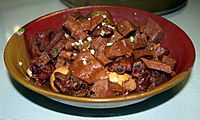Shandong cuisine facts for kids
Quick facts for kids Shandong cuisine |
|||||||
|---|---|---|---|---|---|---|---|

Braised spare ribs with gluten (simplified Chinese: 面筋红烧排骨; traditional Chinese: 麵筋红烧排骨; pinyin: miànjīn hóngshāo páigǔ)
|
|||||||
| Traditional Chinese | 山東菜 | ||||||
| Simplified Chinese | 山东菜 | ||||||
|
|||||||
| Lu cuisine | |||||||
| Traditional Chinese | 魯菜 | ||||||
| Simplified Chinese | 鲁菜 | ||||||
|
|||||||
Shandong cuisine, also known as Lu cuisine, is a famous cooking style from Shandong Province in northern China. It is one of the Eight Great Culinary Traditions of Chinese cuisine. Shandong is a coastal province, so its food often includes lots of fresh seafood.
Contents
What Makes Shandong Cuisine Special?
Shandong cuisine is known for using many different ingredients. It also uses a variety of cooking methods. Chefs often use local animals, birds, seafood, and vegetables.
Cooking Techniques Used in Shandong Cuisine
Some common cooking methods include:
- Bao (爆): Quick frying food very fast.
- Liu (溜): Quick frying with corn flour to make a thick sauce.
- Pa (扒): Stewing, which means cooking slowly in liquid.
- Kao (烤): Roasting food in an oven or over heat.
- Zhu (煮): Boiling food in water.
- Using sugar to make sweet dishes, sometimes with honey.
Styles of Shandong Cuisine
Shandong cuisine has two main styles: Jinan and Jiaodong. Both are known for their fresh, light, and rich flavors. They often use two kinds of broths: a clear one and a milky one. These broths are usually seasoned with green onions and taste great with seafood.
Jiaodong Style: Seafood Focus
The Jiaodong style comes from eastern Shandong. This includes cities like Qingdao and Yantai. It focuses on seafood dishes. These dishes usually have a light and fresh taste.
Jinan Style: Soups and Flavors
The Jinan style comes from Jinan and nearby areas. A special part of this style is using different kinds of soups. Jinan dishes are often sweet, fragrant, and tender.
How Shandong Cuisine Influenced Other Foods
Shandong cuisine is very important in Chinese cooking. Many other cooking styles in China grew from it. Even though it's not as common in Chinese restaurants outside China, it has shaped much of the food in northern China. For example, the food in Beijing and Tianjin comes from Shandong cuisine. Many families in northern China cook using simpler Shandong methods.
Ancient Roots of Shandong Cooking
Long ago, during the Spring and Autumn period (770-221 BCE), Shandong was home to the Qi and Lu states. These areas were rich in food, with mountains, fertile land, and lots of seafood. People there had advanced cooking skills even then. Confucius, a famous thinker born in the Lu state, even talked about food. He suggested eating food that was fresh and prepared well. This shows how refined food was in Shandong a long time ago.
Shandong Cuisine Today
The Shandong cuisine we know today developed during the Yuan dynasty. From there, it spread to northern China, including Beijing. It even influenced the food served to Chinese emperors!
Main Ingredients in Shandong Cuisine
Shandong cuisine uses many traditional ingredients. Since it's a coastal area, seafood is very important.
Seafood Delights
You'll find lots of different seafood here. This includes scallops, prawns, shrimps, clams, sea cucumbers, and squid.
Maize (Corn)
Shandong is special because it uses a lot of maize, or corn. This corn is different from the sweet corn you might know. It's often chewy and starchy. People eat it steamed on the cob or fried.
Peanuts
Shandong is also famous for its delicious peanuts. They are naturally sweet and smell wonderful. Peanuts are often served roasted or stir-fried with salt. They are also used raw in cold dishes.
Grains and Breads
People in Shandong eat many different grains. These include millet, wheat, oats, and barley. They are often cooked as congee (a type of porridge) or made into steamed or fried breads. People in Shandong usually prefer steamed breads over rice as their main food.
Common Vegetables
While Shandong has lots of farms, it traditionally uses fewer types of vegetables than southern China. Common vegetables include potatoes, tomatoes, cabbages, mushrooms, onions, garlic, and eggplant. Green leafy vegetables and bell peppers are also popular. The large, sweet cabbages from central Shandong are famous for their delicate taste. They are a key food during winter.
Shandong Vinegar
One of Shandong's biggest gifts to Chinese cooking is its vinegar. People in Shandong have been making vinegar for hundreds of years. Their special methods make it unique. Shandong vinegar is richer and more complex than other types. Some people even enjoy it on its own!
Images for kids
More Shandong Cuisine Styles
Besides Jinan and Jiaodong, there are other interesting styles within Shandong cuisine.
Jinan Cuisine: Quick and Sweet
Jinan cuisine focuses on quick frying, roasting, and boiling. The food is often sweet, fragrant, fresh, and tender. A famous Jinan dish is stir-fried large yellow croaker with sugar and vinegar.
Jiaodong Cuisine: Seafood and Skill
Jiaodong cuisine is all about cooking and cutting skills. Since it's by the sea, most dishes use seafood. You'll find sea cucumber, abalone, and scallop. A well-known Jiaodong dish is stir-fried sea cucumber with green onions.
Kongfu Cuisine: Food for Confucius's Family
"Kongfu" refers to the family of Confucius. This family had very high standards for their food. So, all Kongfu dishes are beautifully designed and prepared with amazing cutting skills.
Luxinan Cuisine: Healthy and Herbal
"Luxinan" means southwestern Shandong Province. People in this area like to eat healthy food. They often use Chinese medicines and local ingredients in their cooking.






